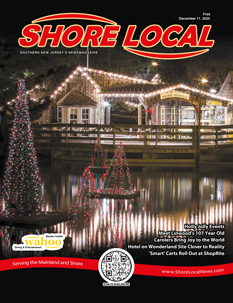Let It Grow
By Tammy Thornton
Well, we have had a good run. After enjoying a warm October and an unseasonably nice November, we must face the reality of cold weather. In the garden, we have finally experienced what’s known as the “killing frost” or “hard frost”. The first fall hard frost is a significant event, because it denotes the end of the growing season as we know it. Some tender plants can withstand a light frost, but, as the morbid name implies, a killing frost is more damaging. A hard frost will kill annuals and other plants that had survived earlier light frosts.

Until now, South Jersey gardeners had been marveling at an extended season, with tomato plants and other vegetables and flowers continuing to produce. In my own garden, nasturtiums, impatiens, and roses had continued to bloom right through Thanksgiving, despite cool weather. But sustained temperatures in the twenties are a different story. You may notice limp stems, shriveled leaves, and flowers that have turned brown.
Fortunately, beneath the earth, life continues, and not all that looks dead is truly lost. Herbaceous perennials die back to the ground, almost forgotten, but their roots, rhizomes, tubers, bulbs, and corms are storing food underground for plants that will resurface in spring. There have been many different years when my camellia had been full of buds until a cold snap. Then, the leaves shriveled and newly opened flowers turned brown, and things looked dire. But as soon as the cold front passed, the leaves unfurled and the camellia went on its happy way, despite losing a few flowers.
However, not all plants are so lucky. What can we do to help our plants survive “the big chill”? Tender perennials can live multiple years, but are native to warmer climates and will usually succumb to the frigid temperatures. If you like to gamble, you can take your chances and see if they make it through winter. It’s always a nice surprise when I find a gardenia or other plant that has unexpectedly survived another year. Those of us closer to the shore can have better luck than our friends to the west and north. A few degrees can make a big difference.
Some parts of your garden can offer more protection than others. Plants close to the house or protected by a fence will be able to survive better than those that are fully exposed. Of course, you don’t want to take chances with a special plant. Before the first frost, bring your prized tender plants indoors to overwinter.
Taking cuttings can be a more manageable way to preserve a piece of the plant if you have limited space indoors. Some plants need a period of dormancy and can rest in a cool garage or basement. Potted plants are particularly susceptible to cold temperatures. Depending on the type of plant, these plants should be stored in a garage or brought indoors. You can also move hardy potted plants to a covered porch for an extra layer of protection. But ideally, they should be planted in the ground in late summer or early fall to give the roots time to establish before the weather gets cold.
Even perennials that normally survive outdoors can be damaged by a hard frost. The fluctuation of freezing and thawing can be more harmful to a plant than consistent low temperatures. Use mulch to protect the roots of your perennials and help regulate the soil temperatures. This will also help protect the soil and plants from heaving, a problem when the soil cracks and the plant lifts, exposing the plant’s roots to extreme temperatures. Leaves can also add a layer of protection to your plants. Just be sure that flat leaves such as maples are not smothering ground covers and herbaceous perennials. You will want to pull the leaves away in early spring as you see plants with new growth (such as spring bulbs or peonies) emerging from the soil. Believe it or not, a blanket of snow can also help insulate plants. As an added benefit, snow can supply nutrients such as nitrogen to the ground, giving it the nickname “poor man’s fertilizer”.
Though you might be longing for a return to summer weather, your garden welcomes a time of rest. Some plants benefit from winter dormancy, and others – like tulips – would not bloom at all if they didn’t have a period of cold. Certain vegetables, like kale, taste sweeter after a light frost. And beneath the ground, a whole world exists in a flurry of activity, preparing for its spring extravaganza.
Tammy Thornton lives with her husband, children, and crazy pets while enjoying a life of gardening, cooking, and going to the beach.












